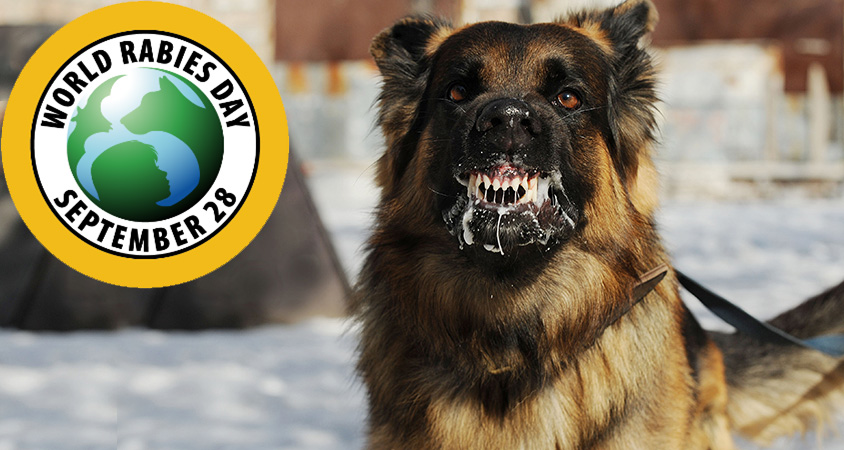Rabies epidemic in India: Its causes, symptoms and prevention

[ad_1]
Rabies is a preventable viral disease most often transmitted through the bite of a rabid animal. The RABV virus infection is the root of the ailment. The virus infects the central nervous system of mammals which ultimately results in brain disease and death. It causes encephalitis (inflammation of the brain) in humans and other mammals.
Rabies was historically referred to as hydrophobia (fear of water) due to the symptom of panic when presented with liquids to drink. It is spread from the saliva of infected animals. The majority of rabies in the United States are linked to skunks, raccoons, bats and foxes. However, dogs continue to carry the rabies virus in many other nations, including India, and dog bites are the leading cause of rabies-related deaths in humans worldwide.
The animals most likely to spread the rabies virus to people include pets and farm animals like cats, cows, dogs, ferrets, goats, horses and wild animals like bats, beavers, coyotes, foxes, monkeys, raccoons, skunks and woodchucks.
How rabies is transmitted
Rabies is caused by the lyssaviruses, including the rabies virus and Australian bat lyssavirus. It is spread through direct contact with saliva or brain/nervous system tissue from an infected animal, such as through a break in the skin or mucous membranes in the eyes, nose, or mouth.
The disease is typically transmitted to humans by an animal’s bite. The risk of contracting rabies from non-bite exposures, such as scratches, abrasions, or open wounds exposed to saliva or other potentially infectious material from a rabid animal is also theoretically possible but unlikely.
Other forms of interaction, for instance caressing a rabid animal or coming into touch with its blood, urine or faeces are not considered to present a risk of infection and are not regarded as rabies exposures to be concerned about. The disease can be diagnosed only after the start of symptoms.
Dogs are the most common animals involved in rabies transmission on a global scale. More than 99% of rabies cases in countries where rabies is often spread are due to dog bites. Less than 5% of rabies cases in the Americas are caused by dog bites with bat bites being the most frequent cause there. Rodents are very rarely infected with rabies.
On rare occasions, the virus has been transferred from an infected organ to recipients of tissue and organ transplants. Furthermore, rabies might be spread by bites and non-bite exposures from an infected individual, but no such cases have been reported.
There is no risk of infection from incidental contact with substances like touching a person who has rabies or touching urine, blood or faeces. Any contact with a person who is undergoing rabies vaccine does not result in rabies exposure, infection risk or the need for postexposure treatment.
When the rabies virus dries up and is exposed to light, it loses its ability to transmit the infection. The rate at which the virus deactivates varies depending on the environment, however normally, if the virus-containing material is dry, the virus can be categorised as non-infectious.
The symptoms of rabies
The rabies virus first reaches the brain following exposure before it is able to begin to produce symptoms. The incubation period is the span of time between exposure and the onset of symptoms. It could continue for weeks or months. The incubation period could change depending on the type of rabies virus, the location of the exposure site (the distance from the brain) and any prior immunity.
The initial signs of rabies, such as weakness or pain, fever, or headache, could resemble those of the flu. Additionally, there might be pain, prickling or an itchy sensation at the part where the animal attacked you. The signs could persist for several days.
The symptoms then intensify to include agitation, anxiety, confusion and brain dysfunction. The person might suffer from delirium, bizarre behaviour, hallucinations, hydrophobia (fear of water) and insomnia as the illness progresses.
In general, the disease’s acute phase lasts between two and ten days. The disease is largely fatal once clinical symptoms of rabies manifest and treatment tends to be supportive. Less than 20 human cases of clinical rabies survival have been recorded. Only a small number of survivors had never received pre or postexposure prophylaxis.
Postexposure prophylaxis (PEP) consists of a dose of human rabies immune globulin (HRIG) and rabies vaccine given on the day of the rabies exposure, and then a dose of vaccine given again on days 3, 7, and 14.
The symptoms, indications and prognosis of rabies in animals can differ. Animal symptoms often mimic human ones. Early nonspecific signs, immediate neurologic problems and ultimately mortality are some of them.

The prevention of rabies
Rabies is a deadly but preventable viral disease. A life can be saved by being aware of rabies risk and knowing what to do if you come into contact with an animal. A strategy to prevent rabies is to keep away from wildlife. All wildlife, especially injured animals, should be left alone. Don’t handle an injured animal. instead, get in touch with the appropriate authorities to request help.
Preventing rabies in pets is a crucial step in reducing the number of human rabies cases since pets can contract the disease from wild animals and then potentially carry it to humans. In the event that you do come into contact with a rabid animal, timely and adequate medical attention would completely prevent rabies in people. If you are uncertain about whether you require PEP or have been bitten or scratched, consult a healthcare professional.
Every dog and cat older than four months need to have a rabies vaccination and always keep your vaccines up to date. Cats and dogs should be kept under supervision and they cannot be left unattended.
When compared to pets under their owners’ control, roaming or stray animals are more likely to have been exposed to rabies. Do not approach stray or unfamiliar cats or dogs. Animals on the loose are more prone to attack people and have rabies exposure. Keep pets and stray animals separate.

If an animal bites, scratches, or comes into contact with you wash the wound thoroughly right away as well as scrub and flush for a few minutes with lots of soap and water. Any animal bite should be reported right away to your local animal control agency, police department or health department for further investigation. If the animal is stray or wild identify it and keep watching it to help with ultimate capture, but refrain from exposing yourself to risk again.
An intramuscular regimen of four 1-mL doses of the HDCV or PCEC vaccination is recommended for previously unvaccinated people. The four-dose course’s initial dose needs to be given as soon as feasible following exposure. On days 3, 7, and 14 following the initial immunisation, further doses should be administered. Adults should always receive the immunisation intramuscularly in the deltoid region (arm).
The anterolateral side of the thigh is also appropriate for children. Since delivery of the rabies vaccination in this location is thought to induce lower neutralising antibody titers, the gluteal region should never be used for injections.
Wild animals should be left alone. Although they seem friendly, stay away from them and never encourage one to feed from your hand. Do not be afraid of them, rather, respect them and keep your distance.

The epidemic of rabies in India
The number of human deaths globally due to dog-mediated rabies is estimated to be 59,000 annually. India is responsible for 36% of rabies-related deaths worldwide, according to the statistics of the World Health Organisation. Moreover, India is responsible for 65% of the such fatalities in South-East Asia. The National Rabies Control Programme recorded 6644 medically suspected cases and fatalities of rabies between 2012 and 2022.
The unexpected increase in rabies infections in India is a serious public health issue. Deaths from rabies among both vaccinated and unprotected people have raised a lot of public concern, particularly in Kerala. Within the last five years, the state has seen a two-fold increase in the number of sick canines.
A comparable study conducted in 2016 indicated that 32% of the 300 samples obtained from dogs tested positive for rabies, while this year, 168 samples (or 56% of the total) did. More than 200,000 dog bite instances and 21 fatalities, almost twice as many as during the previous year have been reported by the state, 12 of which have been confirmed by a laboratory.
Despite getting anti-rabies immunoglobulin (RIG) and a vaccine, six of the patients, including a 12-year-old child, passed away. 250 anti-rabies shots were given out without the necessary quality checks due to a serious vaccine shortage brought on by an upsurge in rabies cases.
The new Thai Red Cross Schedule for intramuscular (IM) and intradermal (ID) immunisation is presently implemented in India. The current post-exposure prophylaxis (PEP) protocol calls for either five intramuscular (IM) doses on days 0–3, 7–14, and 28 or eight ID doses (two locations per visit). Ineffective RIG administration, non-administration or inadequate wound care allows the virus additional time to proliferate. A painful consequence could occur even with the right PEP.
The body’s production of antibodies and the virus’s ability to enter the brain compete for control of the body once the vaccination is given. It has been hypothesised that the vaccination wouldn’t have enough time to work if damaged areas of the body were close to the brain or rich in nerve tissue. Therefore, RIG must be administered as soon as feasible for passive immunity because the vaccination alone cannot protect against rabies in category III exposure. There have also been a few documented instances of fraudulent or subpar vaccines and cold chain failure.
307 died of rabies in India last year
India records 1.7 crore dog bites per year, per the Association of Prevention and Control of Rabies in India (APCRI). In 2022, rabies claimed the lives of 307 people. Delhi had the most occurrences (48), West Bengal came in second (38) while Maharashtra, Karnataka, and Andhra Pradesh each had 29 fatalities.
The information was provided in answer to a query posed by Dean Kuriakose, the Congress MP from Idukki, Kerala, last week, by SP Singh Baghel, the Union minister of state for health and family welfare, during the current monsoon session of the Lok Sabha. Rabies is a major cause of morbidity and mortality in India, according to the National Centre for Disease Control (NCDC).
“A large stray dog population and limited success in control methods, such as mass dog vaccination and animal birth control, are among the reasons for the high number of animal bite and rabies cases in India. Almost all of these deaths can be prevented with safe and efficacious rabies vaccines, but somehow the efforts have fallen short so far,” stated Indian Medical Association’s central working committee member, Dr Sharad Gupta.
Why India is struggling with rabies
The Global Alliance for Rabies Control (GARC), the World Organisation for Animal Health (OIE), the Food and Agriculture Organisation of the United Nations (FAO), and nations from all around the world convened in December 2015 to discuss eradicating human rabies mortality by the year 2030. In her own words, WHO Director-General Dr. Margaret Chan stated that eradicating rabies is a possibility. She remarked, “Rabies belongs in the history books.”
With a high prevalence of the disease and the ability to mobilise the support of other nations in the region owing to its wealth of technical expertise and resources, India has to play a significant role in the effort to eradicate human mortality from dog-mediated rabies by the year 2030.
According to specialists, this is feasible only if the Indian government changes the status of rabies and makes it a “notifiable” illness like tuberculosis or polio. It basically means that the government would give it the attention it requires, calculating the incidence rate, tracking the development, and providing resources along with money.
For example, health clinics across the nation would need to maintain sufficient supplies of the rabies shot, as opposed to the existing scenario, in which clinics in rural locations frequently run out of supplies or lack the competent staff to administer a full course of injections. Along with the essential issue of immunising and sterilising stray dogs, a government strategy would need to include a campaign to raise public awareness.
India now has more stray dogs than ever before. An estimate puts the number at 35 and 40 million. There are bound to be packs of dogs everywhere in the streets. The animals are typically fed by dog lovers, but no one is in charge of administering their shots. A dog can have numerous puppies in a year even after vaccination and before sterilisation, which starts the cycle all over again.
The population of stray dogs must be sterilised and immunised in order to eradicate rabies which is challenging. It is difficult to capture stray dogs, not lumbering and obese labradors, rather tough and street-smart animals to vaccinate them.
The dogs are able to observe the dog catchers coming from a mile away which starts a chase that could or might not end with a dog being caught, rendered immobile, and given a shot. Dog vaccination is typically given low priority by most municipal authorities, who already have to deal with significant pollution, waste handling and homelessness challenges.
Conclusion
Controlling rabies is proving to be a difficult task for India with the problem gradually escalating every year. As Dr Reeta Mani, Associate Professor of India’s National Institute of Mental Health & Neurosciences (NIMHANS) highlighted, “Control of canine rabies through vaccination and dog birth control is imperative, although with 25 million stray dogs in the country, this is a formidable task.”
However, the country has an impressive history of completely eradicating severe diseases like plague, leprosy, and smallpox in spite of all the challenges. She further added, “Collaborative efforts between the medical, veterinary, and public health sectors have already made a significant difference. We have seen improved rates of pre-exposure vaccination (PrEP) for vulnerable populations, such as children, and improved awareness of the need for post-exposure prophylaxis (PEP) after a bite.”
Just like before, India needs to make a concentrated and dedicated effort in order to make progress in this direction along with better facilities and support from all sections to comprehend the gravity and risk the disease poses to society.
An extensive plan needs to be devised on the part of the government and implemented to tackle the menace of rabies and people need to understand that one can practice their love for dogs and animals without putting the lives of others in danger. The matter requires us to be sensitive towards others, particularly children, who are the main victims of all of this.
[ad_2]
Source link



